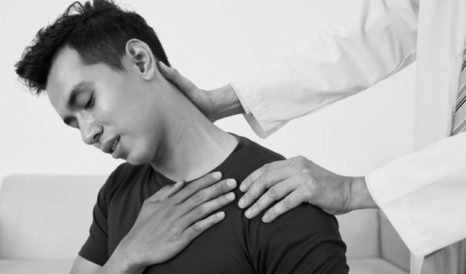Rotator Cuff Tear: Symptoms and Causes
Feeling pain in your shoulder when reaching up or lying on it at night? You may have a rotator cuff tear injury. Learn more about the symptoms and causes.
If you feel pain in your shoulder when you are reaching up or lying on it at night, there’s every chance you have what’s known as a rotator cuff injury.

Your shoulder is a ‘ball and socket’ joint – the ‘ball’ is on your upper arm bone (the humerus head), and the ‘socket’ is in the front of your shoulder bone (scapula). The bones are held in place by tendons and ligaments, which also connect your collarbone (clavicle) to the joint.
The rotator cuff is a group of four muscles that come together as tendons, forming a ‘cuff’ or tube around the head of the humerus and the front of your shoulder blade. These tendons are vital in stabilising and enabling movement of your shoulder.
What is a rotator cuff tear?
The tendons and muscles around your shoulder joint can get torn as a result of injury.
There are two different types of rotator cuffs tears:
- Partial tear (incomplete tear). The tendon is damaged, but is not completely severed.
- Full-thickness tear (complete tear). An acute rotator cuff injury separates all of the tendon from the bone.
What causes a rotator cuff tear?
Acute tears
These usually happen if you fall on an outstretched arm. The tendons of your shoulder joint can also get damaged if you suddenly lift something heavy, putting too much stress on the upper arm muscles and tearing them away from the shoulder bones.
Other injuries can occur along with an acute rotator cuff tear – a hard fall on an outstretched arm commonly causes a broken collarbone or a dislocated shoulder.
Degenerative tears
A rotator cuff tear can also be the result of repetitive overhead movements, particularly in sport (tennis players are often at risk) or if you do a lot of overhead work. The tendons become weaker with wear and tear, and can eventually tear. This is more common in older people – the blood supply to tendons is lower, meaning they are less able to repair themselves.
Repetitive movement can also lead to bone degeneration – which can cause bony lumps called bone spurs to grow on the inside of your shoulder joint. These can catch on the tendons, causing them to tear.
What are the most common symptoms of a torn rotator cuff?
If you have had an acute injury, such as a fall, you’re likely to feel an intense pain, possibly with a snapping sensation and immediate weakness in your upper arm.
Other symptoms include:
- Pain at night, especially if you’re lying on the affected shoulder
- Pain when lifting and lowering your arm
- Weakness when lifting or rotating your arm
- A grinding sensation when moving your shoulder
How are rotator cuff tears diagnosed?
As with all joint injuries, the sooner you get diagnosed, the more effective your treatment is likely to be.
A diagnosis will usually start with a physical examination to assess your range of movement. If you have typical symptoms of a rotator cuff tear, an MRI scan or ultrasound scan can be used to assess soft tissue damage.
How are rotator cuff tears treated?
Depending on the type and severity of the tear, you might be able to treat the injury conservatively with physiotherapy to help build up the muscles and regain full function.
Anti-inflammatories and steroid injections can also be used to reduce any swelling and improve function in your joint.
If you’ve had symptoms for more than a few months, or if you have a severe tear, surgery might be necessary – particularly for more active people. The operation is done arthroscopically – a minimally invasive technique using a tiny camera and small surgical instruments. Any bone spurs can be removed, and torn tendons can be re-attached to the humerus head.
Simon Moyes is an internationally renowned orthopaedic surgeon and leader in the field of arthroscopic (keyhole) surgery. His Capital Orthopaedics team works from The Cromwell Hospital in London, with its state-of-the-art diagnostic and surgical equipment, and top sports medicine professionals.
